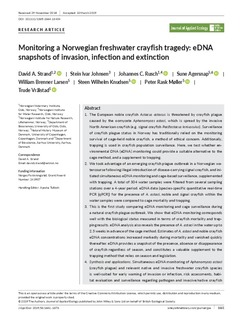| dc.contributor.author | Strand, David | |
| dc.contributor.author | Johnsen, Stein Ivar | |
| dc.contributor.author | Rusch, Johannes | |
| dc.contributor.author | Agersnap, Sune | |
| dc.contributor.author | Larsen, William Brenner | |
| dc.contributor.author | Knudsen, Steen Wilhelm | |
| dc.contributor.author | Møller, Peter Rask | |
| dc.contributor.author | Vrålstad, Trude | |
| dc.date.accessioned | 2019-10-08T07:16:40Z | |
| dc.date.available | 2019-10-08T07:16:40Z | |
| dc.date.created | 2019-05-29T18:00:12Z | |
| dc.date.issued | 2019 | |
| dc.identifier.citation | Journal of Applied Ecology. 2019, 56 (7), 1661-1673. | nb_NO |
| dc.identifier.issn | 0021-8901 | |
| dc.identifier.uri | http://hdl.handle.net/11250/2620733 | |
| dc.description.abstract | 1. The European noble crayfish Astacus astacus is threatened by crayfish plague caused by the oomycete Aphanomyces astaci, which is spread by the invasive North American crayfish (e.g. signal crayfish Pacifastacus leniusculus). Surveillance of crayfish plague status in Norway has traditionally relied on the monitoring survival of cage‐held noble crayfish, a method of ethical concern. Additionally, trapping is used in crayfish population surveillance. Here, we test whether environmental DNA (eDNA) monitoring could provide a suitable alternative to the cage method, and a supplement to trapping. 2. We took advantage of an emerging crayfish plague outbreak in a Norwegian watercourse following illegal introduction of disease‐carrying signal crayfish, and initiated simultaneous eDNA monitoring and cage‐based surveillance, supplemented with trapping. A total of 304 water samples were filtered from several sampling stations over a 4‐year period. eDNA data (species‐specific quantitative real‐time PCR [qPCR]) for the presence of A. astaci, noble and signal crayfish within the water samples were compared to cage mortality and trapping. 3. This is the first study comparing eDNA monitoring and cage surveillance during a natural crayfish plague outbreak. We show that eDNA monitoring corresponds well with the biological status measured in terms of crayfish mortality and trapping results. eDNA analysis also reveals the presence of A. astaci in the water up to 2.5 weeks in advance of the cage method. Estimates of A. astaci and noble crayfish eDNA concentrations increased markedly during mortality and vanished quickly thereafter. eDNA provides a snapshot of the presence, absence or disappearance of crayfish regardless of season, and constitutes a valuable supplement to the trapping method that relies on season and legislation. 4. Synthesis and applications. Simultaneous eDNA monitoring of Aphanomyces astaci (crayfish plague) and relevant native and invasive freshwater crayfish species is well‐suited for early warning of invasion or infection, risk assessments, habitat evaluation and surveillance regarding pathogen and invasive/native crayfish status. This non‐invasive, animal welfare friendly method excludes the need for cage‐held susceptible crayfish in disease monitoring. Furthermore, eDNA monitoring is less likely to spread A. astaci than traditional methods. This study resulted in the implementation of eDNA monitoring for Norwegian crayfish plague and crayfish surveillance programmes, and we believe other countries could improve management strategies for freshwater crayfish using a similar approach. | nb_NO |
| dc.language.iso | eng | nb_NO |
| dc.relation.uri | https://datadryad.org/resource/doi:10.5061/dryad.vf86jb2 | |
| dc.rights | Navngivelse 4.0 Internasjonal | * |
| dc.rights.uri | http://creativecommons.org/licenses/by/4.0/deed.no | * |
| dc.subject | Krepsdyr | nb_NO |
| dc.subject | Crustacea | nb_NO |
| dc.subject | Akvatisk fauna | nb_NO |
| dc.subject | Aquatic fauna | nb_NO |
| dc.subject | Oomyceter / Eggsporesopper | nb_NO |
| dc.subject | Oomycetes | nb_NO |
| dc.subject | Krepsepest | nb_NO |
| dc.subject | Crayfish plague | nb_NO |
| dc.subject | Miljø DNA | nb_NO |
| dc.subject | Environmental DNA | nb_NO |
| dc.subject | EDNA baserte metoder | nb_NO |
| dc.subject | EDNA based methods | nb_NO |
| dc.subject | Akvatisk miljø | nb_NO |
| dc.subject | Aquatic environment | nb_NO |
| dc.subject | Tifotkreps | nb_NO |
| dc.subject | Decapod crustaceans | nb_NO |
| dc.title | Monitoring a Norwegian freshwater crayfish tragedy: eDNA snapshots of invasion, infection and extinction | nb_NO |
| dc.type | Journal article | nb_NO |
| dc.type | Peer reviewed | nb_NO |
| dc.description.version | publishedVersion | nb_NO |
| dc.rights.holder | © 2019 The Authors | nb_NO |
| dc.subject.nsi | VDP::Basale medisinske, odontologiske og veterinærmedisinske fag: 710 | nb_NO |
| dc.subject.nsi | VDP::Basic medical, dental and veterinary sciences: 710 | nb_NO |
| dc.source.pagenumber | 1661-1673 | nb_NO |
| dc.source.volume | 56 | nb_NO |
| dc.source.journal | Journal of Applied Ecology | nb_NO |
| dc.source.issue | 7 | nb_NO |
| dc.identifier.doi | 10.1111/1365-2664.13404 | |
| dc.identifier.cristin | 1701469 | |
| dc.relation.project | Norges forskningsråd: 243907 | nb_NO |
| cristin.unitcode | 7464,30,19,0 | |
| cristin.unitname | Ferskvannsøkologi | |
| cristin.ispublished | true | |
| cristin.fulltext | original | |
| cristin.qualitycode | 2 | |

